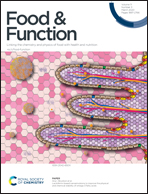Physical properties and cookie-making performance of oleogels prepared with crude and refined soybean oil: a comparative study
Abstract
The objective of this research was to fabricate crude soybean oil oleogels (CSO) using β-sitosterol (BS) and/or monoacylglycerol (MAG) and compare their role with that of refined soybean oil oleogels (RSO) in cookie making. Both crude and refined soybean oil oleogels were formed with BS or MAG, or the combination of both (1 : 1) at a fixed concentration of 10 wt%. The thermal behavior of the oleogels was measured using differential scanning calorimetry (DSC). The crystal structure and morphology of the oleogels were characterized using X-ray diffraction (XRD) and polarized light microscopy (PLM). The hardness of the oleogel and commercial vegetable shortening was compared using a texture analyzer. The characteristics of cookies made with the oleogels were compared with those of cookies made with commercial vegetable shortening. Overall, the incorporation of BS and/or MAG into crude and refined soybean oil can produce oleogels with solid-like properties. Refined soybean oil formed stronger and firmer oleogels as compared to crude soybean oil. RSO structured by BS presented branched fiber-like, elongated plate-like, and needle-like crystals while the same oil gelled by MAG contained spherulite crystals. RSO made with the combination of BS and MAG displayed crystal morphologies from both BS and MAG. The same crystal morphologies were observed in CSO with lower quantities. Comparing the quality of cookies made with the oleogels and commercial vegetable shortening, equal or better performance of both RSO and CSO in terms of weight, thickness, width, spread ratio, and hardness of cookies than that of commercial vegetable shortening was observed. By combining the results of the physical characterization and cookie making performance, it can be concluded that both crude and refined soybean oleogels could resemble commercial shortening, which offers the possibility of using oleogels to replace shortening in the baking industry.



 Please wait while we load your content...
Please wait while we load your content...